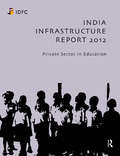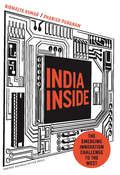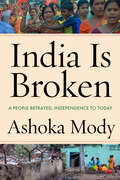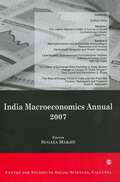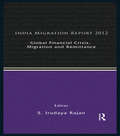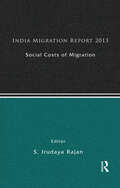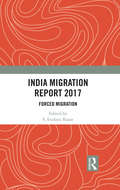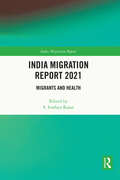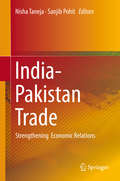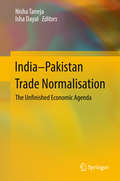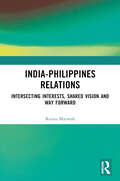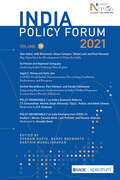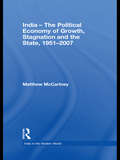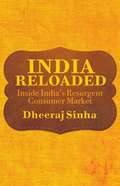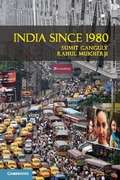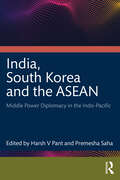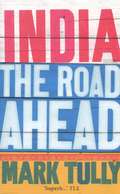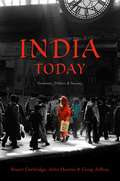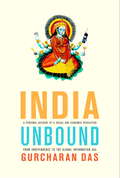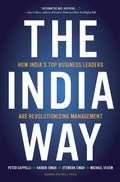- Table View
- List View
India Inc.
by Vikas PotaIndia is on its way to giving the world a new generation of role models. India Inc. reveals who makes the list of up-and-coming entrepreneurs and business leaders, and explains what makes them unique. Sifting through jargon, Vikas Pota explains how readers can follow these top earners to create their own success.
India Infrastructure Report 2012: Private Sector in Education
by Idfc FoundationToday, India’s education sector remains a victim of poor policies, restrictive regulations and orthodoxy. Despite being enrolled in schools, children are not learning adequately. Increasingly, parents are seeking alternatives through private inputs in school and tuition. Students are dropping out from secondary school in spite of high financial returns of secondary education, and those who do complete it have inferior conceptual knowledge. Higher education is over-regulated and under-governed, keeping away serious private providers and reputed global institutes. Graduates from high schools, colleges and universities are not readily employable, and few are willing to pay for skill development. Ironically, the Right to Education Act, if strictly enforced, will result in closure of thousands of non-state schools, and millions of poor children will be left without access to education. Eleventh in the series, India Infrastructure Report 2012 discusses challenges in the education sector — elementary, secondary, higher, and vocational — and explores strategies for constructive change and opportunities for the private sector. It suggests that immediate steps are required to reform the sector to reap the benefits from India’s ‘demographic dividend’ due to a rise in the working age population. Result of a collective effort led by the IDFC Foundation, this Report brings together a range of perspectives from academics, researchers and practitioners committed to enhancing educational practices. It will be an invaluable resource for policymakers, researchers and corporates.
India Inside
by Phanish Puranam Nirmalya KumarThanks to its ability to innovate, the developed world will always have a distinct advantage over the developing world, right? Not according to leading management experts Nirmalya Kumar and Phanish Puranam. In India Inside, the authors draw on their research to show how India is already turning this assumption on its head-often in ways invisible to consumers in the developed world.Through their research and extensive interviews with India-based executives from such companies as AstraZeneca, GE, Infosys, Intel, and Wipro, the authors unveil the dramatic rise in invisible innovation occurring in India-from B2B products and R&D outsourcing to process and management innovation. The book also illuminates Indian companies' growing ability to innovate consumer products that are compact, low-cost, efficient, and robust in the face of harsh environmental conditions. The authors' analysis makes clear that for certain kinds of innovation, the long-held monopoly of the developed world is over.India Inside provides a wake-up call for executives and policy makers in the developed world and a clear-eyed view of both the challenges and opportunities facing multinationals seeking new sources of innovation in the future.
India Is Broken: A People Betrayed, Independence to Today
by Ashoka ModyA provocative new account of how India moved relentlessly from its hope-filled founding in 1947 to the dramatic economic and democratic breakdowns of today. When Indian leaders first took control of their government in 1947, they proclaimed the ideals of national unity and secular democracy. Through the first half century of nation-building, leaders could point to uneven but measurable progress on key goals, and after the mid-1980s, dire poverty declined for a few decades, inspiring declarations of victory. But today, a vast majority of Indians live in a state of underemployment and are one crisis away from despair. Public goods—health, education, cities, air and water, and the judiciary—are in woeful condition. And good jobs will remain scarce as long as that is the case. The lack of jobs will further undermine democracy, which will further undermine job creation. India is Broken provides the most persuasive account available of this economic catch-22. Challenging prevailing narratives, Mody contends that successive post-independence leaders, starting with its first Prime Minister, Jawaharlal Nehru, failed to confront India's true economic problems, seeking easy solutions instead. As a popular frustration grew, and corruption in politics became pervasive, India's economic growth relied increasingly on unregulated finance and environmentally destructive construction. The rise of a violent Hindutva has buried all prior norms in civic life and public accountability. Combining statistical data with creative media, such as literature and cinema, to create strong, accessible, people-driven narratives, this book is a meditation on the interplay between democracy and economic progress, with lessons extending far beyond India. Mody proposes a path forward that is fraught with its own peril, but which nevertheless offers something resembling hope.
India Macroeconomics Annual 2007
by Sugata MarjitThe ongoing focus of this Annual will be to analyse macroeconomic events in contemporary India using macroeconomic and statistical tools. While one part of the Annual will be devoted to macroeconomic issues, the other part will carry academic research papers encompassing a wide range of topics such as labour, fiscal issues, banking and finance, international trade, econometrics, computational and mathematical methods. The focus of this section will be on problems affecting the economy in general and will take a broader view of topics relevant to developing countries.
India Migration Report 2012: Global Financial Crisis, Migration and Remittances (India Migration Report)
by S. Irudaya RajanThis volume is a collection of articles dealing with various dimensions of the Global Financial Crisis and its economic and social impact in terms of governance, emigration, remittances, return migration and re-integration. The crisis, which had its origin in the United States in 2008, spread its economic effects on developed as well as developing countries. Some of these countries were able to recover in the short run while some are in the process of recovery, with continuous efforts by both national governments and international agencies. In this backdrop, is there any impact on the outflow of emigrants from the countries of origin and inflow of remittances to the countries of destination? The third volume in the annual series ‘India Migration Report’ answers the question through rigorous quantitative and qualitative analyses and fieldwork both in the Gulf region and South Asia, and concludes that both emigration and remittances are more resilient than expected. This report: contains findings based on an extensive survey conducted in Kerala; has additional evaluations based on other surveys and case studies conducted in different parts of India, Pakistan, Bangladesh, Nepal and Sri Lanka to reflect on the consequences of the global crisis on the countries of origin, as well as a quick assessment and site visits to the United Arab Emirates, Kuwait, Qatar and Malaysia; includes essays that examine the linkages between emigration and remittances based on international data from the World Bank, the International Labour Organization, the International Organization of Migration, the United Nations and other organizations that closely deal with international migration. It will be of interest to students and scholars of migration studies, sociology, law, economics, gender studies, diaspora studies, international relations and demography, apart from non-governmental organizations, policy-makers and government institutions working in the field of migration.
India Migration Report 2013: Social Costs of Migration
by S. Irudaya RajanThis volume is an empirical assessment of an often-neglected space in migration research — social, psychological and human costs for both migrants and the families they leave behind — based on qualitative and quantitative research findings. Globally, the focus of migration research has consisted of the intersections of migration and remittances. This overemphasis on remittances obscures the contributions and sacrifices made by migrants and their families. With this backdrop in view, India Migration Report 2013 documents issues such as: • Children’s negotiation of parental migration • Coping mechanisms adopted by women left behind • Utilization of social networks by the elderly during a health crisis • Demographic implications of migration • Household management and child care by spouses of migrant nurses • Lifestyle management by the elderly, who migrate with their children, in the absence of other traditional and familiar kinship structures • Transition costs involved in peasant migration • Social costs of migration in the case of emigration to the Gulf region • Broader impacts of migration on the family In addition, the book also includes articles dealing with nurses’ migration, skilled mobility, informalization of labour markets, mobility of women workers, global financial crisis and return migration, remittances management and a critical assessment of bilateral mobility agreements among nations to protect Indian workers. It will be of interest to those in migration studies, sociology, law, economics, gender studies, diaspora studies, international relations and demography, apart from non-governmental organizations, policy-makers and governmental institutions working in the field of migration.
India Migration Report 2017: Forced Migration (India Migration Report)
by S. Irudaya RajanThe India Migration Report 2017 examines forced migration caused by political conflicts, climate change, disasters (natural and man-made) and development projects. India accounts for large numbers of internally displaced people in the world. Apart from conflicts and disasters, over the years development projects (including urban redevelopment and beautification), often justified as serving the interests of the people and for public good, have caused massive displacements in different parts of the country, disrupting the lives and livelihoods of millions of people. The interdisciplinary essays presented here combine a rich mix of research methods and include in-depth case studies on aspects of development-induced displacement affecting diverse groups such as peasants, religious and ethnic minorities, the poor in urban and rural areas, and women, leading to their exclusion and marginalization. The struggles and protests movements of the displaced groups across regions and their outcomes are also assessed. This volume will be of great interest to scholars and researchers of development studies, economics, sociology and social anthropology and migration studies.
India Migration Report 2020: Kerala Model of Migration Surveys
by S. Irudaya RajanIndia Migration Report 2020 examines how migration surveys operate to collect, analyse and bring to life socio-economic issues in social science research. With a focus on the strategies and the importance of information collected by Kerala Migration Surveys since 1998, the volume: Explores the effect of male migration on women left behind; attitudes of male migrants within households; the role of transnational migration and it effect on attitudes towards women; Investigates consumption of remittances and their utilization; asset accumulation and changing economic statuses of households; financial inclusion of migrants and migration strategies during times of crises like the Kerala floods of 2018; Highlights the twenty-year experience of the Kerala Migration Surveys, how its model has been adapted in various states and led to the proposed large-scale India Migration Survey; and Explores issues of migration politics and governance, as well as return migration strategies of other countries to provide a roadmap for India. The volume will be of interest to scholars and researchers of development studies, economics, demography, sociology and social anthropology, and migration and diaspora studies.
India Migration Report 2021: Migrants and Health (India Migration Report)
by S. Irudaya RajanIndia Migration Report 2021 presents a detailed study on the health of migrants. It highlights major healthcare challenges faced by migrant labourers, especially in the context of the COVID-19 pandemic, which has forced authorities, policymakers and many other stakeholders to turn their attention to healthcare delivery unlike ever before. Bringing to the fore the health status of the migrant population both before the pandemic and during the pandemic, the essays in this volume discuss • the ease of access of migrant labourers to primary healthcare services; • the safety challenges faced by migrant workers at their workplaces, their exposure to various physical and psychological health vulnerabilities, and prevalence of potentially malignant health disorders and mental health issues among migrant labourers; • gendered access to healthcare, gender-based violence at workplaces and the gender-related perceptions on topics such as employment, decision-making and general attitude; • the role of decentralization and local self-government institutions in enabling health systems to address health problems of migrants, government policies and programs aimed at providing welfare for return emigrants from the Gulf; • the vulnerabilities migrant workers have encountered across the Indian states during the pandemic, with regards to food insecurity and psychological distress, and the type of support they received from various stakeholders. The volume will be of interest to scholars and researchers of development studies, economics, demography, sociology and social anthropology, and migration and diaspora studies.
India on the Move
by Emily J. Thompson Richard H.K. VietorBy 2003, India had been growing at almost 6% annually since 1992, after it suffered a financial collapse, abandoned import substitution, and moved gradually to adopt the Washington Consensus. Now, financial controls and competition barriers are less burdensome, inflation is lower, and the current account is balanced. However, the finance minister faces difficulties with massive fiscal deficits and continuing disturbances with Pakistan that seem to deter foreign direct investment (FDI). The question facing him is whether India can reduce these deficits (in the face of a 2004 election) or whether to let them slide, hoping that India's entrepreneurs and high-tech southern states will carry the day.
India-Pakistan Trade
by Nisha Taneja Sanjib PohitExamining the implications of recent important developments, the primary aim of this book is to bridge the gaps in existing literature on India-Pakistan economic engagement and to examine various aspects of the trade normalization process. The book includes familiar themes of India-Pakistan bilateral trade in goods and services, providing new insights into the potential for trade and the challenges involved in realizing it. The respective chapters examine the current trade trends and identify the possible sectors for bilateral FDI flows between the two countries, which could help forge deeper economic ties between them. In light of India's changed investment policy, this analysis is pertinent for investors and policy-makers alike. The book also includes chapters on a variety of unconventional subjects, such as estimating the levels of informal trade, an analysis of a trade perception survey and identifying trade potential using a CGE modeling approach. Further, a number of sectors have been identified for in-depth analysis, including sports goods, healthcare and energy. These sector-based analyses reflect the gap between current levels of trade in the selected industries and the possible trade potential. The studies identify key tradable commodities in the health and sports industries, as well as opportunities for trading in energy. The book thus provides readers with a deep understanding of the process of normalizing economic relations and enhancing bilateral trade at the micro and macro levels, on the basis of which the authors subsequently provide recommendations for policymakers.
India-Pakistan Trade Normalisation
by Nisha Taneja Isha DayalThis book explores the unfinished India-Pakistan Trade normalisation agenda (building upon the themes covered in the book "India-Pakistan Trade: Strengthening Economic Relations" published by Springer in 2014) and discusses the steps that must be undertaken in order to move the bilateral engagement forward. Given the commencement of bilateral state-level talks and the Indian government's emphasis on South Asian integration, it adds impetus to the trade liberalisation process, while also providing essential recommendations for policymakers in both countries. The unfinished agenda faces obstacles such as the list of items for which export from India to Pakistan continues to be restricted; lack of land borders and seamless cross-border transport services, which hampers the realisation of trade potential; negative reporting in the media, which influences traders' perceptions; and the continued occurrence of informal trade resulting from inadequacies of formal trade relations. The book examines various sectors, including the agricultural, textiles, automotive and pharmaceutical industries, given their predominance on the list of restricted items for bilateral trade. It also covers studies on unconventional and under-researched themes concerning informal trade, informational barriers to India-Pakistan trade, and opening new land borders for trade - all of which can play a facilitating role in realizing the untapped trade potential between India and Pakistan. The book also includes the second round of the India-Pakistan trade perception survey, which identifies impediments to India-Pakistan bilateral trade and assesses the change in traders' perceptions since the first round of the survey, which was published in 2014.
India-Philippines Relations: Intersecting Interests, Shared Vision and Way Forward
by Reena MarwahThis book outlines 75 years of robust and multi-dimensional diplomatic relations between two democracies – India and the Philippines. Through nine chapters, penned by relying mainly on primary documents, published works, and consultations with experts and practitioners, this book takes the reader beyond historical, civilisational, political and economic synergies to locate the partnership and its potential in both bilateral and multilateral areas.This volume responds to questions such as: What explains the need to strengthen India-Philippines partnership undergirded by their historical, diasporic and cultural affinities? How have both New Delhi and Manila reassessed their economic and strategic visions in the context of the transforming Indo-Pacific discourses? Given that defence cooperation has been the hallmark of trust building, how has this been reflected in their shared visions for regional security, peace and prosperity? Finally, what are the key sectors and catalysts for forging closer cooperation for the next 25 years of India-Philippines diplomatic relations?Print edition not for sale in South Asia (India, Sri Lanka, Nepal, Bangladesh, Pakistan and Bhutan)
India Policy Forum 2016–17: Volume 13
by Shekhar Shah Barry Bosworth Karthik MuralidharanThe India Policy Forum (IPF) is India’s most prominent annual economic policy conference in the summer season of New Delhi and is organized by NCAER, the National Council of Applied Economic Research. The primary goal of the IPF is to promote original policy and empirical research on India, including policy-focused review articles that seek to define the best economic policy advice based on robust, empirical research. The annual IPF conference provides a unique combination of intense scholarship and expert commentary on commissioned research papers with a strong focus on policy. The revised papers and conference proceedings are published in this volume, including the comments of paper discussants and a summary of the floor discussion on each paper. This 2016-17 IPF volume brings together the papers presented at the 13th IPF Conference held on July 12-13, 2016. The paper by C. Badarinza, V. Balasubramaniam, and T. Ramadorai presents for the first time an integrated perspective on the balance sheet of Indian households. The paper by R Nagaraj and T. N. Srinivasan unpacks the analytical and data issues underlying the controversy surrounding India’s new GDP estimates. The paper by A. Adhvaryu, P. Bharadwaj, and S. Krumholz analyzes India’s experience with child health and development, and suggests how policy and programs can be made more effective in this vital area. The paper by S. Chatterjee and D. Kapur raises troubling questions about the performance of Indian agriculture and highlights six puzzles, related among other things to the political economy, trade, and productivity of Indian agriculture. The final paper synthesizes knowledge and weighs the evidence from an array of studies on India’s National Rural Employment Guarantee Scheme, the world’s largest workfare program.
India Policy Forum 2021: Volume 18
by Poonam Gupta Barry Bosworth Karthik MuralidharanThe India Policy Forum (IPF) is India's most prominent annual economic policy conference in the summer season of New Delhi and is organized by NCAER, the National Council of Applied Economic Research. The primary goal of the IPF is to promote original policy and empirical research on India, including policy-focused review articles that seek to define the best economic policy advice based on robust, empirical research. The annual IPF conference provides a unique combination of intense scholarship and expert commentary on commissioned research papers with a strong focus on policy. The revised papers and conference proceedings are published in this volume, including the comments of paper discussants and a summary of the floor discussion on each paper.
India - The Political Economy of Growth, Stagnation and the State, 1951-2007 (India in the Modern World)
by Matthew McCartneyUnderstanding the drivers and inhibitors of economic growth is critical for promoting development in less developed countries, including India. This book examines economic growth in India from 1951 to the present, challenging many accepted orthodox views. It argues that growth and stagnation should be considered over the medium term, and that the precise role of the state – in relation to particular historical and political-economic circumstances – is more important than the overall level of state involvement or disengagement. The book uses an empirical approach to contend that the state has an important role in several key areas including: mobilising a surplus; allocating the surplus in an efficient way to productive investment projects; and in building institutions (including political parties) through which conflict can managed between the different losers and rent-seekers affected by economic changes. It shows how, over time and in periods of growth and stagnation, the state in India has acted in key areas, and how the actions of the state has had a profound impact on economic outcomes. Overall, the book makes a major contribution to understanding the economic history of development in India and to understanding the role of the state in economic development more generally.
India Reloaded
by Dheeraj SinhaBrands and businesses from across the globe have tried to leverage the India opportunity, based upon simplistic and widely-held assumptions. This book takes a critical look at these myths and contradictions from an inside perspective, presenting a fresh and nuanced perspective on the opportunities that the Indian market offers. It draws upon a wealth of data, from consumer research, market data, macroeconomic research, popular culture and case studies, to provide a thorough and compelling insight into what makes for success in the complex Indian market, based upon two decades of experience.
India Since 1980
by Rahul Mukherji Šumit GangulyThis book considers the remarkable transformations that have taken place in India since 1980, a period that began with the assassination of the formidable Prime Minister Indira Gandhi. Her death, and that of her son Rajiv seven years later, marked the end of the Nehru-Gandhi era. Although the country remains one of the few democracies in the developing world, many of the policies instigated by these earlier regimes have been swept away to make room for dramatic alterations in the political, economic and social landscape. Sumit Ganguly and Rahul Mukherji, two leading political scientists of South Asia, chart these developments with particular reference to social and political mobilization, the rise of the BJP and its challenge to Nehruvian secularism and the changes to foreign policy that, in combination with its meteoric economic development, have ensured India a significant place on the world stage.
India, South Korea and the ASEAN: Middle Power Diplomacy in the Indo-Pacific
by Harsh V PantWith the US-China geostrategic competition heating up, it is an opportune time for South Korea, ASEAN and India to draw on their middle power status to bolster regional security and economic cooperation to protect their interests from any potential superpower fallout. This book investigates the diverse possibilities for collaboration within the India-ASEAN-ROK trilateral framework. It explores the various avenues of cooperation that this new trilateral initiative can benefit from, ranging from security, economic, institutional platforms and technology to sustainable development and climate change. The book provides regional perspectives on India, ASEAN and ROK to show the growing appetite in these countries for such trilateral initiatives and to forecast the challenges that may arise.Lucid and topical, this book will be an essential read for scholars and researchers of political science, international relations, diplomacy and strategic studies, as well as Southeast Asian, East Asian and South Asian studies. It will also be of use to thinktanks and policymakers interested in Indo-Pacific, India-ASEAN and India-ROK issues.
India: State Capacity and Unity in Diversity
by Matthew C. Weinzierl Robert Scherf Alberto F. CavalloAs 2018 drew to a close, India prepared to once again carry out the largest democratic exercise in human history, as in less than six months more than 850 million eligible voters would have the chance to choose their representatives to the Lok Sabha-the country's lower house of parliament-and, thus, their country's Prime Minister and cabinet.[i] The election would pit the ruling party-the Bharatiya Janata Party (Indian People's Party, known as the BJP) led by Prime Minister Narendra Modi-against a collection of parties that included the once-dominant Indian National Congress party (Congress). The 2019 elections would serve as a referendum on Modi's first term in office and, therefore, on a high stakes question: had India's implausibly robust democracy produced the right leader for the right moment, or had it taken the wrong path?
India the Road Ahead
by Mark TullyFull of fascinating stories of real people at a time of great change, it will be of interest to economists, business people, diplomats, politicians, as well as to those who love to travel and who take an interest in the rapid growth of one of the world's largest countries, and what this means to us in the West.
India Today: Economy, Politics and Society
by Stuart Corbridge John Harriss Craig Jeffrey<p>Twenty years ago India was still generally thought of as an archetypal developing country, home to the largest number of poor people of any country in the world, and beset by problems of low economic growth, casteism and violent religious conflict. Now India is being feted as an economic power-house which might well become the second largest economy in the world before the middle of this century. Its democratic traditions, moreover, remain broadly intact. <p>How and why has this historic transformation come about? And what are its implications for the people of India, for Indian society and politics? These are the big questions addressed in this book by three scholars who have lived and researched in different parts of India during the period of this great transformation.</p>
India Unbound: The Social And Economic Revolution From Independence To The Global Information Age
by Gurcharan DasIndia today is a vibrant free-market democracy, a nation well on its way to overcoming decades of widespread poverty. The nation's rise is one of the great international stories of the late twentieth century, and in India Unbound the acclaimed columnist Gurcharan Das offers a sweeping economic history of India from independence to the new millennium. Das shows how India's policies after 1947 condemned the nation to a hobbled economy until 1991, when the government instituted sweeping reforms that paved the way for extraordinary growth. Das traces these developments and tells the stories of the major players from Nehru through today. As the former CEO of Proctor & Gamble India, Das offers a unique insider's perspective and he deftly interweaves memoir with history, creating a book that is at once vigorously analytical and vividly written. Impassioned, erudite, and eminently readable, India Unbound is a must for anyone interested in the global economy and its future.From the Trade Paperback edition.
The India Way
by Michael Useem Jitendra Singh Peter Cappelli Harbir SinghExploding growth. Soaring investment. Incoming talent waves. India's top companies are scoring remarkable successes on these fronts - and more.How? Instead of adopting management practices that dominate Western businesses, they're applying fresh practices of their ownin strategy, leadership, talent, and organizational culture.In The India Way, the Wharton School India Team unveils these companies' secrets. Drawing on interviews with leaders of India's largest firms - including Mukesh Ambani of Reliance Industries, Narayana Murthy of Infosys Technologies, and Vineet Nayar of HCL Technologies - the authors identify what Indian managers do differently, including:Looking beyond stockholders' interests to public mission and national purposeDrawing on improvisation, adaptation, and resilience to overcome endless hurdlesIdentifying products and services of compelling value to customersInvesting in talent and building a stirring cultureThe authors explain how these innovations work within Indian companies, identifying those likely to remain indigenous and those that can be adapted to the Western context.With its in-depth analysis and research, The India Way offers valuable insights for all managers seeking to strengthen their organization's performance.

